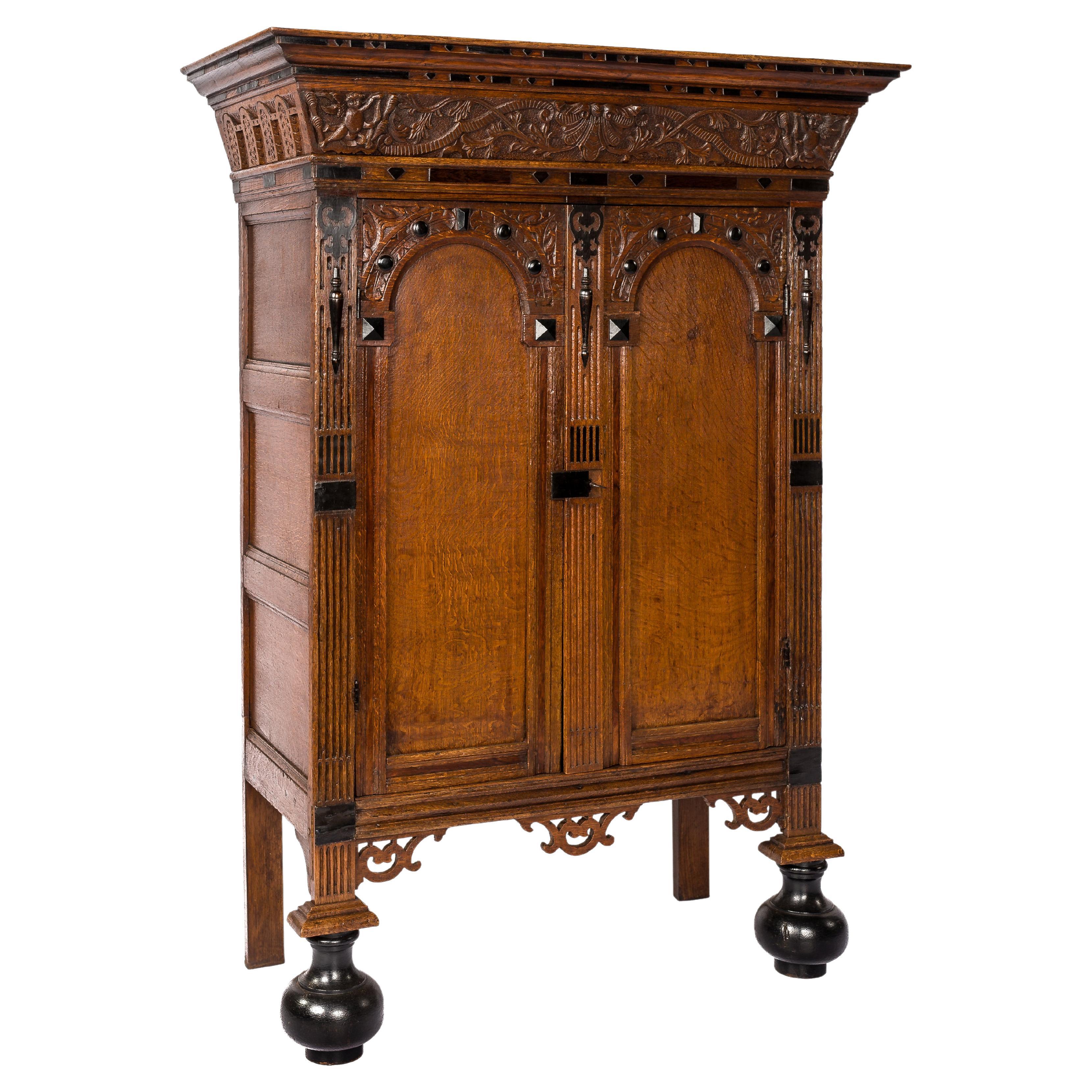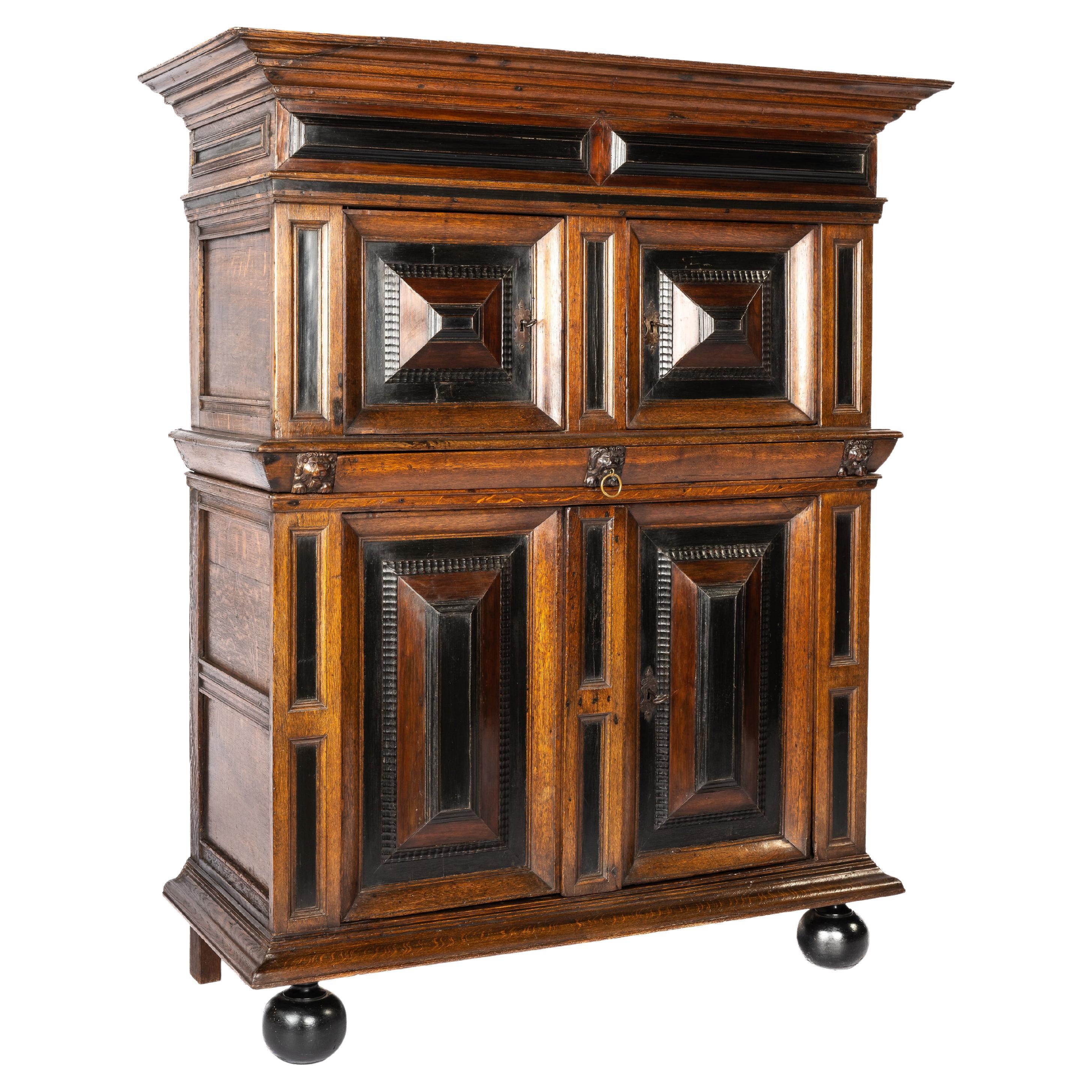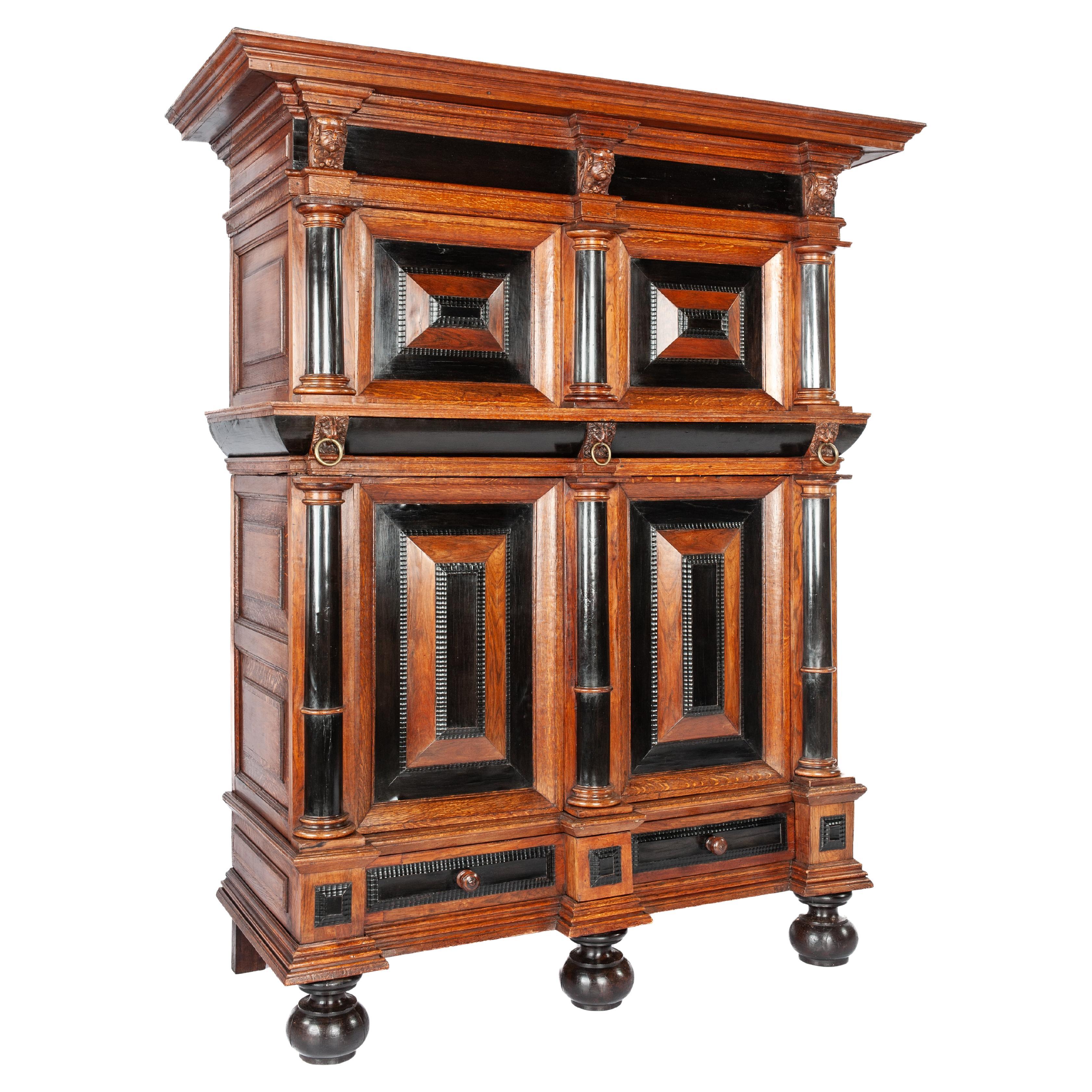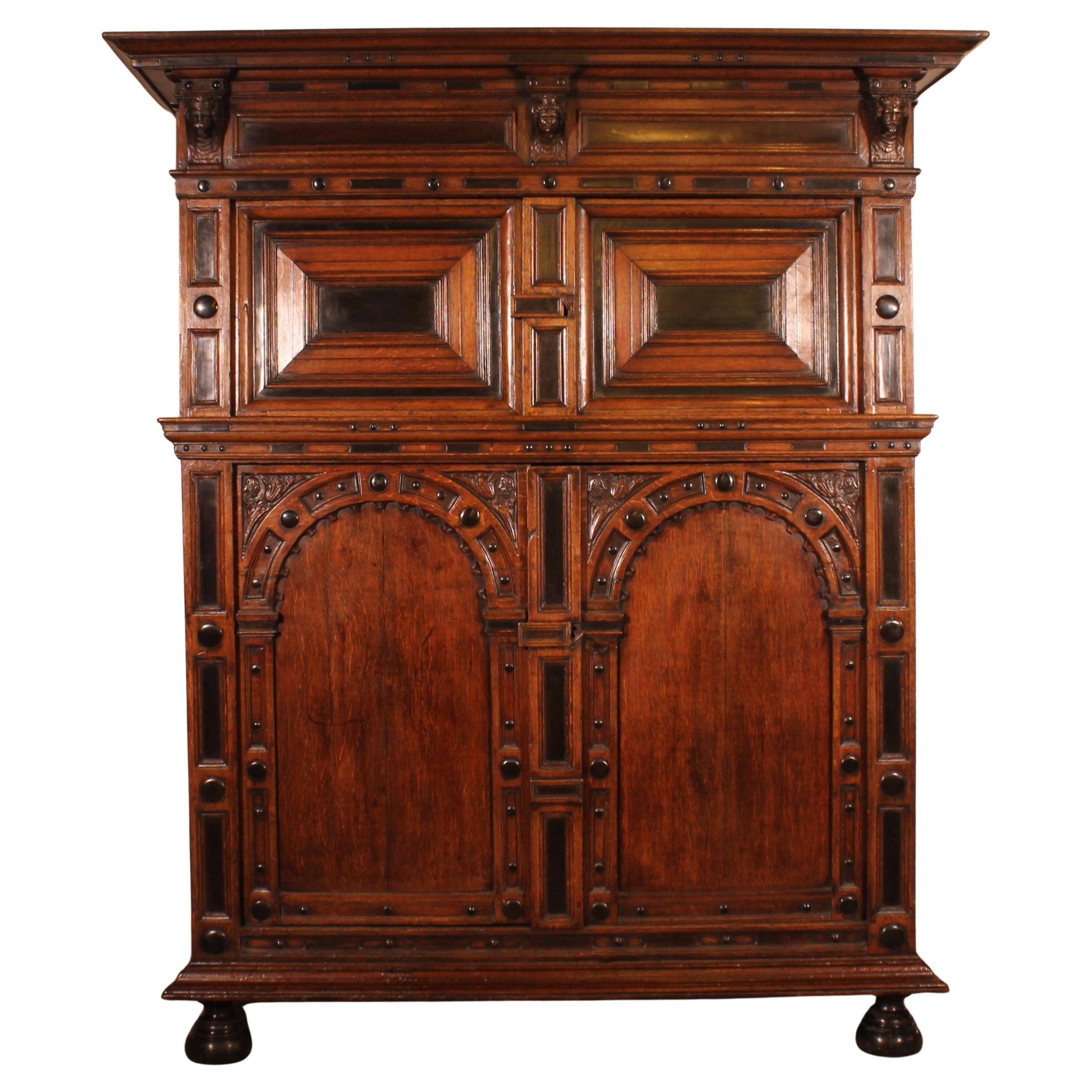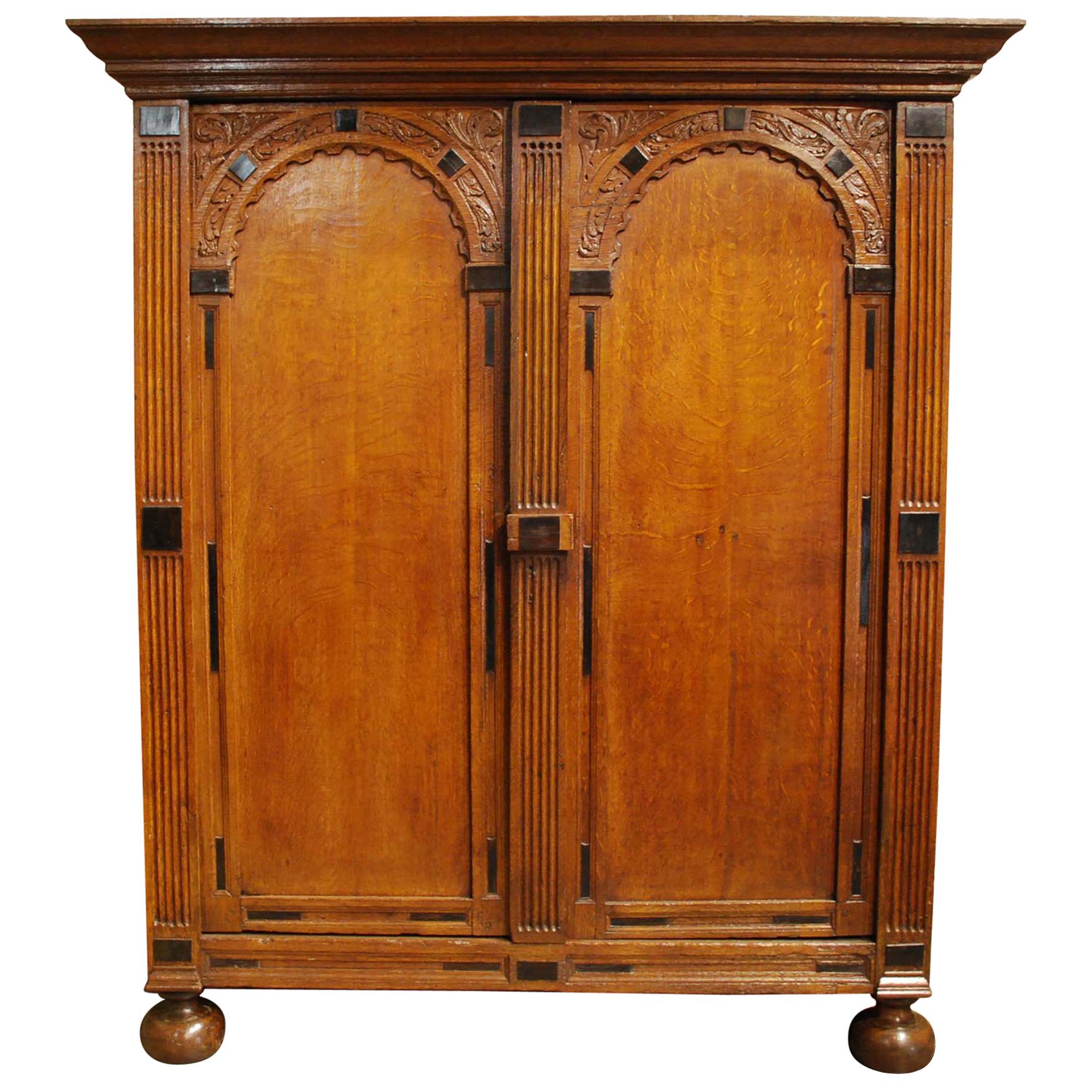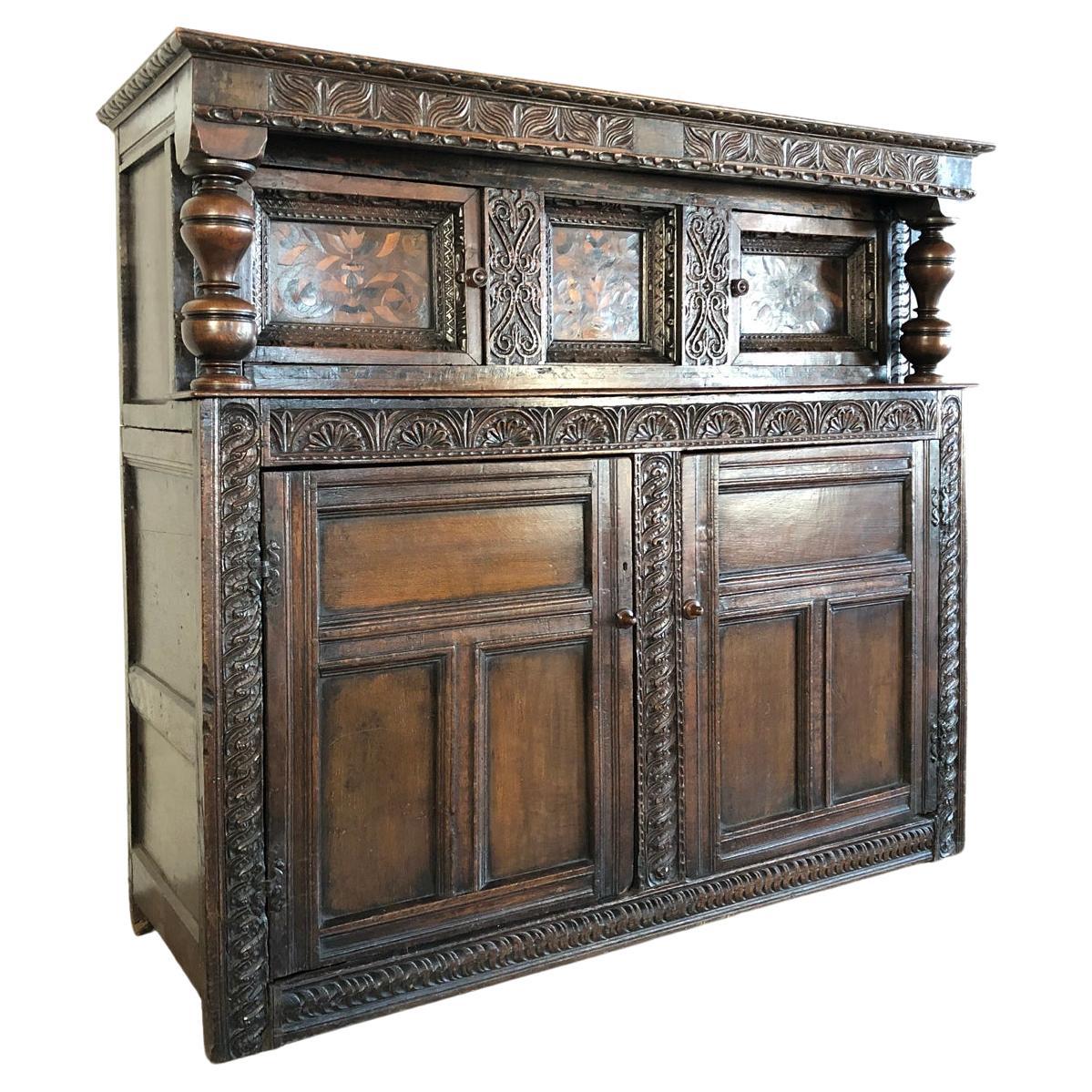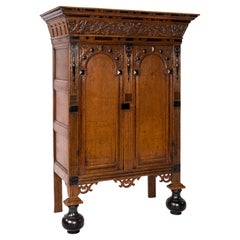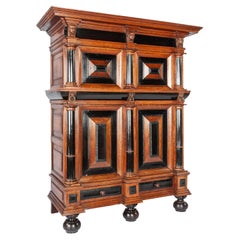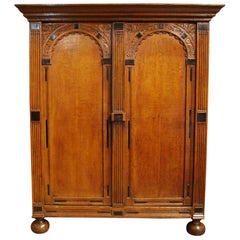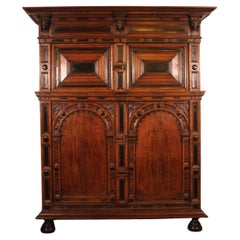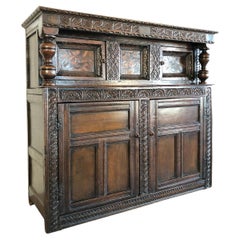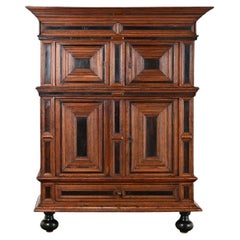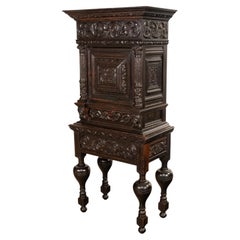Items Similar to 17th Century Dutch Renaissance Oak and Ebony Inlay Four-Door Cabinet Dated 1660
Video Loading
Want more images or videos?
Request additional images or videos from the seller
1 of 21
17th Century Dutch Renaissance Oak and Ebony Inlay Four-Door Cabinet Dated 1660
$27,022.19
£19,901.79
€22,500
CA$36,761.58
A$40,850.23
CHF 21,405.95
MX$500,955.22
NOK 273,020.45
SEK 256,847.62
DKK 171,289.04
Shipping
Retrieving quote...The 1stDibs Promise:
Authenticity Guarantee,
Money-Back Guarantee,
24-Hour Cancellation
About the Item
This extraordinary cabinet is made of the finest watered oak in the tradition of the Dutch Renaissance during the “Dutch golden age”
It is a four-door cabinet made in the Provence of Utrecht in 1660 as is dated on the piece. The arched doors and sides are typical for this province and this type of cabinet is also known as “Utrechtse Poortkast”, or portal cabinet. The piece can be disassembled in two pieces, an upper and a lower cabinet. Above the doors of the lower cabinet sits a hand-carved frieze with a central shield dated 1660 flanked by two cornucopias and an acanthus. The piece was further enriched with many ebony inlaid panels. When this cabinet was made, ebony was more expensive than gold. The amount of ebony on this cabinet makes it a very special piece of furniture. The cabinet has the original forged steel hinges locks and keys. On the interior of the upper cabinet on the right side, an additional vault is situated. The cabinet stands on ebonized bun feet.
The piece is of exceptional quality and was made completely in watered oak. Watering is the placing of freshly cut wood in water, usually from nine months to three years, up to ten years for oak. As a result, the minerals, nutrients, and starch present in the wood are dissolved in the water. It used to be thought that this made the wood more durable, but it has been found that watered wood develops fewer hairline cracks when drying and that this is the cause of it being more durable. Prolonged watering also wears out the wood, making it 'quieter', keeping the beams and planks cut from it straight. The cabinet was probably commissioned by a merchant who had taken part in a successful trading expedition and wanted to show off his newly acquired riches. The sheer size of the piece, as well as the craftsmanship of the work, is second to none.
The height of the piece is 86.42 inches, the depth (measures at the hull) 24.61 inches, and 29.92 inches at the top. The width is (measured at the hull) 58.46 inches and 68.70 inches at the top.
The Dutch golden age
The 17th century was an important century for the Netherlands. The region separated from the Spanish Empire and formed its own republic. Dutch merchants established their first colonies in the Americas and opened up trade networks around the world. The Dutch economy flourished as much of Europe's trade began passing through Amsterdam. This money helped foster the arts, leading to the rise of Rembrandt, Vermeer, and Rubens. This was the Dutch Golden Age.
The strong Dutch economy and celebration of the arts provided the financial and cultural security to inspire middle and upper-class citizens to buy lots of furniture. This was a big change from the sparsely furnished homes of medieval times. Dutch patrons demanded high-quality, comfortable, and stylish products, and furniture makers obliged. Dutch furniture of the 17th century was lighter, more comfortable, and more versatile than in many other parts of the world.
A key form of Dutch furniture in the 17th century was the cabinet, a taller furniture item that had replaced ground-level medieval chests. Cabinets were essential furniture items in most Dutch homes, as well as in the Dutch colonies. Since cabinets were generally used to hold valuable items like linens or silverware, they were works of art themselves, and we see some of the most important styles of Dutch furniture applied here.
Note: There is a decent amount of ebony veneer incorporated in this cabinet. Ebony is a species restricted under the CITES act. However, the ebony being veneer, makes the total weight of the ebony way below its restrictions, as well as the fact the piece was made in 1660. It can therefore be freely shipped across borders.
- Dimensions:Height: 86.42 in (219.5 cm)Width: 68.71 in (174.5 cm)Depth: 29.93 in (76 cm)
- Style:Renaissance (Of the Period)
- Materials and Techniques:
- Place of Origin:
- Period:Mid-17th Century
- Date of Manufacture:1660
- Condition:Wear consistent with age and use.
- Seller Location:Casteren, NL
- Reference Number:1stDibs: LU970928314132
About the Seller
4.9
Platinum Seller
Premium sellers with a 4.7+ rating and 24-hour response times
Established in 1975
1stDibs seller since 2013
433 sales on 1stDibs
Typical response time: 1 hour
- ShippingRetrieving quote...Shipping from: Casteren, Netherlands
- Return Policy
Authenticity Guarantee
In the unlikely event there’s an issue with an item’s authenticity, contact us within 1 year for a full refund. DetailsMoney-Back Guarantee
If your item is not as described, is damaged in transit, or does not arrive, contact us within 7 days for a full refund. Details24-Hour Cancellation
You have a 24-hour grace period in which to reconsider your purchase, with no questions asked.Vetted Professional Sellers
Our world-class sellers must adhere to strict standards for service and quality, maintaining the integrity of our listings.Price-Match Guarantee
If you find that a seller listed the same item for a lower price elsewhere, we’ll match it.Trusted Global Delivery
Our best-in-class carrier network provides specialized shipping options worldwide, including custom delivery.More From This Seller
View AllAntique 17th Century Dutch Oak and Ebony Two-Door Renaissance Cabinet
Located in Casteren, NL
Antique 17th Century Dutch oak and ebony two-door Renaissance cabinet.
This extraordinary cupboard is made of the finest quarter-sawn oak...
Category
Antique 17th Century Dutch Renaissance Cabinets
Materials
Ebony, Oak
$14,372 Sale Price
20% Off
Antique 17th Century Dutch Renaissance Solid Oak with Ebony Veneer Cupboard
Located in Casteren, NL
This beautiful and friendly-sized cupboard is made of the finest watered oak in the tradition of the Dutch Renaissance during the “Dutch golden age” It is a two-story four-door cabin...
Category
Antique 17th Century Dutch Renaissance Cabinets
Materials
Ebony, Oak
Antique 17th Century Oak Dutch Renaissance Cabinet with Ebony and Mahogany
Located in Casteren, NL
On offer here is an antique four-door cupboard, in Dutch, named “Kussenkast”, that was made in the Northern Netherlands in the late 17th century. This cupboard takes its name from th...
Category
Antique Late 17th Century Dutch Renaissance Cupboards
Materials
Brass, Steel
$24,019 Sale Price
20% Off
Antique 17th Century Oak and Ebony Two-Door Renaissance Cabinet
Located in Casteren, NL
This extraordinary cupboard is made of the finest quarter sawn oak in the tradition of the Dutch Renaissance during the “Dutch golden age”
It is a small two-door cabinet with arche...
Category
Antique Mid-17th Century Dutch Renaissance Cabinets
Materials
Ebony, Oak
Exceptional Antique 18th century Dutch Renaissance Golden Age oak Portal Cabinet
Located in Casteren, NL
This extraordinary Utrecht “Poortkast” (portal cabinet) stands as one of the finest expressions of Dutch Renaissance furniture. Crafted in ...
Category
Antique Early 18th Century Dutch Renaissance Cabinets
Materials
Oak
Antique 18th century Dutch Renaissancewarm brown oak two door cabinet
Located in Casteren, NL
This antique Dutch Renaissance cabinet was crafted in the southern Netherlands at the end of the 18th century, around 1780. It serves as a quintessential example of the furniture cra...
Category
Antique Late 18th Century Dutch Renaissance Cabinets
Materials
Oak
$11,019 Sale Price
20% Off
You May Also Like
17th Century Oak And Ebony 4-door Sideboard - Netherlands
Located in Brussels, Brussels
Superb and rare four door oak and ebony sideboard from the early 17th century from the Netherlands.
Exceptional Renaissance work composed of two doors at the bottom with arches deco...
Category
Antique 17th Century Dutch Renaissance Wardrobes and Armoires
Materials
Oak
English Charles I 17th Century Oak and Inlaid Court Cupboard
Located in Troy, NY
Large English Charles I Oak and Inlaid Court Cupboard, Yorkshire circa 1640, having a boarded top with a delicately carved edge above a leave-carved frie...
Category
Antique 1640s English Jacobean Cupboards
Materials
Wood
Dutch 18th Century Oak & Ebonized Armoire
Located in Baton Rouge, LA
A Dutch armoire made of solid oak from the 1700’s. This armoire has geometric paneling instead of the classic pillowed carvings of the similarly styled Dutch kussenkast...
Category
Antique 18th Century Dutch Other Cabinets
Materials
Oak
Antique 17th Century Dutch Carved Ebonized Oak Credence Cabinet on Stand 1680
Located in Portland, OR
A good antique late 17th Century carved ebonized oak cabinet on stand, circa 1680.
Such cabinets are commonly referred to as credence or chalice cabinets, referring to a ecclesiastic...
Category
Antique 1690s Dutch Baroque Cabinets
Materials
Oak
19th-Century Dutch Mannerism Oak Cabinet
Located in Opole, PL
19th-Century Dutch Mannerism Oak Cabinet
A Dutch cabinet in the Dutch Mannerism style, dated to the 2nd half of the 19th century, made of oak wood. The front is supported by spheric...
Category
Antique Mid-19th Century Dutch Renaissance Revival Cabinets
Materials
Oak
17th Century Dutch Oak Cabinet
Located in Gloucestershire, GB
A 17th century Dutch oak cabinet of nice small proportions and finely balanced carvings to the moulded panel doors. Having a moulded cornice top abov...
Category
Antique 17th Century Cabinets
Materials
Oak
More Ways To Browse
Dutch Antique Furniture
Antique Weights And Measures
Antique 17th Century Dutch
Hand Carved Frieze
Antique Four Panel Doors
Ebony Inlay
Dutch Door
Used Steel Doors
Used Dutch Doors
Antique Ebony Cabinet
Antique Ship Door
Arched Wood Doors
17th Century Keys
17th Century Carved Cabinet
Antique Steel Cabinet
Arched Interior Door
17th Century American Furniture
Dutch Oak Cabinet
